The
ways by which stars are added to the
canton of a flag are very varied,
and the different techniques
employed are often good indictors
that help to determine a flag's date
and usage. Here we explore the
various techniques and terminology
related to the application of stars
to an American flag.
Methods for applying stars that I am
familiar with are: sewing, painting,
printing, clamp-dying, gluing,
stamping, embroidering, crocheting,
affixing and reverse-appliqué.
There may be other methods, and I
encourage other collectors to share
their experiences with other
techniques. The effect of each
technique leaves a distinct
character on the flags themselves,
and is an important aspect in the
great variability of American flags.
Sewn Stars
Of
the methods for applying stars by
sewing them to a flag, the two
predominant methods are
single-appliqué and double-appliqué.
On single-appliqué flags, the maker
cuts a hole in the blue canton in
the shape of a star and uses a
single piece of white fabric to
create the star. Although the
term "single-appliqué" is commonly
used to describe this "cut through"
approach, it would also accurately
describe flags with stars only sewn
to one side of the canton. On
double-appliqué flags, the maker
cuts two white stars and stitches
them back-to-back, one on each side
of the canton.
|
Single Appliqué
 |
Technique: Sewn,
Single-Appliqué. This
photo shows beautiful
single-appliqué work on a
magnificent 4-5-4 pattern
maritime flag made in
Boston, circa 1870, by the
firm of Leighton and
Pollard. The entire
flag is hand-sewn. |
 |
|
Double Appliqué
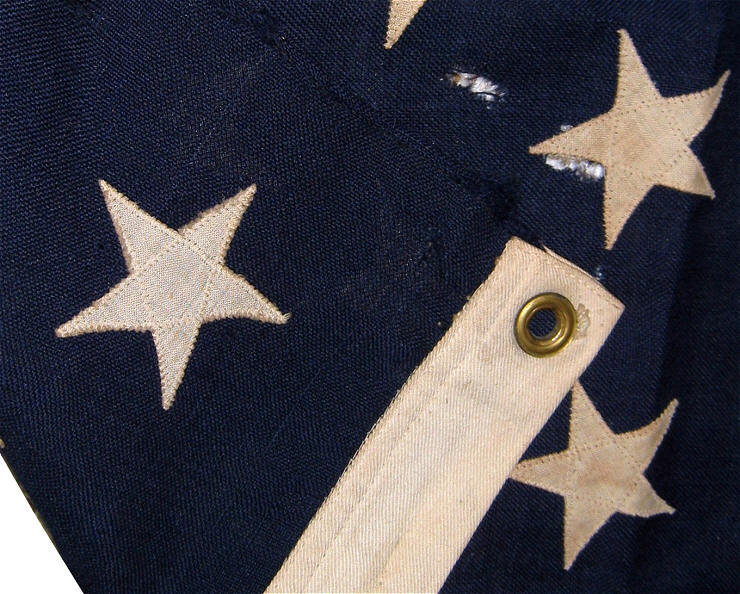 |
Technique: Sewn,
Double-Appliqué. The
stars on this late period 13
star ensign are sewn onto
both sides of the canton,
back to back. The use
of a zig-zag stitch that
crosses the center of the
star indicates that the flag
is most likely not earlier
than 1892 when the zig-zag
stitch technique for
applying stars was patented. |
 |
Painted Stars
Painting is an obvious choice for
applying stars to a flag, yet
painted flags are somewhat scarce.
The reason is most likely because
flags, being made from fabric, have
always been sewn by seamstresses who
most likely find it natural to
simply sew fabric stars, rather than
switching to another medium.
There are some cases, however, where
painting stars makes sense, and each
case is shown here. One case
is where painting allows easier
production of complex designs.
A second case is the use of gilt
paint on silk flags, a technique
typically reserved for military
flags where strong, light, silk is
better suited to weathering harsh
battlefield conditions than other
materials such as cotton, where the
flags are lighter than wool flags
when carried on horseback, and where
the integrity of the silk,
un-punctured by sewn stars, most
likely resulted in less tearing and
breakdown. A third case is
where materials are scarce or the
flag is made hastily from readily
available materials, one of which is
paint. A fourth case is where
specialized paints increase the
lifespan of the flag and afford it
certain properties, such as a higher
degree of reflectivity and a
protection against discoloration
with age.
Printing
Printing stars is actually a
misnomer. In fact, in most
cases, the stars are not printed,
but rather the blue canton around
the stars, and the stars themselves
remain the color of the base fabric
of the flag. Printed parade
flags most commonly fall into this
category.
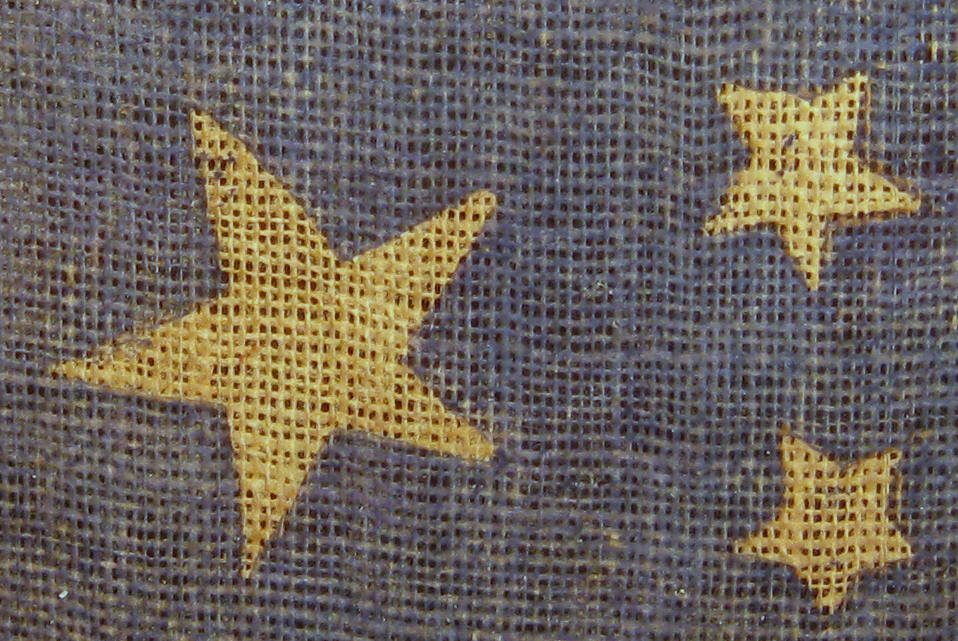 |
Technique: Printed.
This is a close up view of
the canton of the
Andersonville Prison
flag. This is a good
view of a printed parade
flag that is solidly
attributed to the the period
of the Civil War.
|
 |
Clamp Dyeing
The
process for clamp dyeing involves
clamping the fabric of the flag such
that the shape of the stars is
clamped and does not take on dye.
The process dates to the mid-19th
century. Once the section of
the flag which is clamped is dyed
and dries, the clamps are removed
and the stars remain the color of
the base fabric. In theory
this could be a process that could
scale to mass production and produce
large flags without the need for
sewing stars (unlike the process of
printing, which becomes cumbersome
the larger the flag). In
practice, bleeding of the dye into
the star region resulted in a
perception of manufacturing defects,
therefore making the process less
commercially successful than hoped.
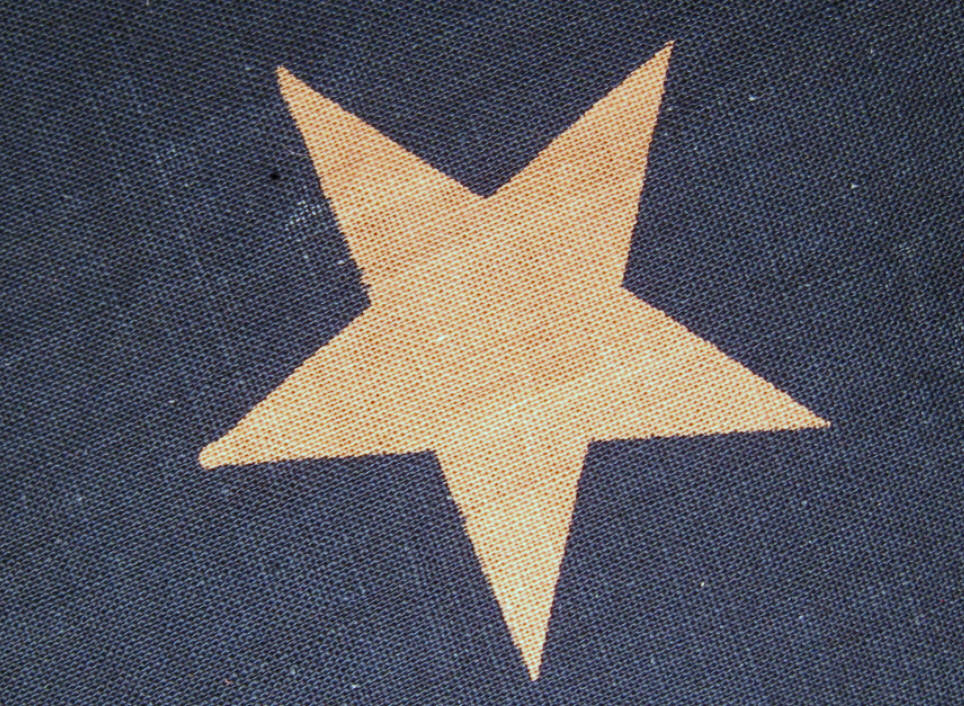 |
Technique: Clamp Dyeing.
Close examination of this
star shows some of the
irregularities introduced by
clamp dying, such as the
stubby tip of one of the
star points and some minor
bleeding of the blue into
the white area of the star.
This unusual flag features
54 stars and dates to the
early 20th century. |
 |
Stamping
Although it's debatable whether
stamping is simply another method of
applying painted stars, I include it
as a separate category simply
because it is a variation of a
technique to apply the stars.
A stamp in the shape of a star might
be fashioned from wood, metal,
rubber, or another material, and
then dipped into paint and pressed
onto the flag. This differs
from actual painting where a brush
is used to apply the paint, and
close inspection of some painted
flags shows evidence of stamping as
the technique for applying the
paint.
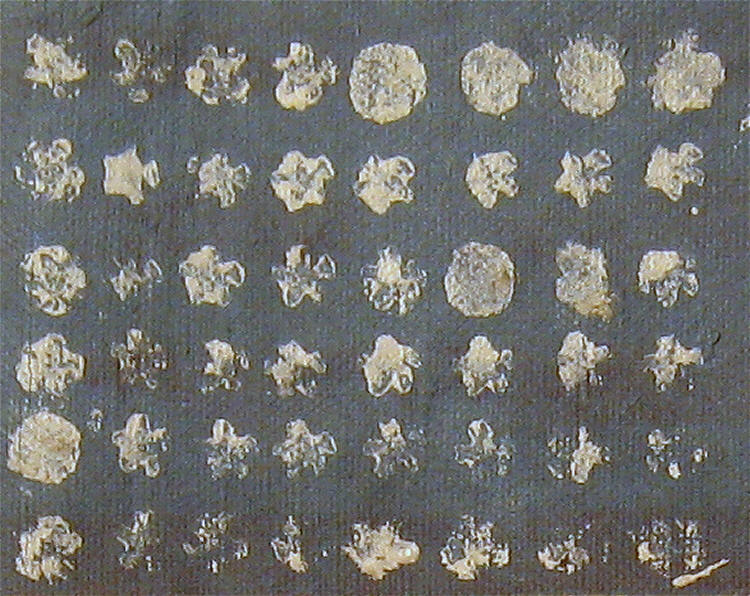 |
Technique: Stamping.
This close up view of a
Liberation Flag made in
Calais, France in 1944 to
welcome American soldiers
shows evidence of stamped
stars. The stars are
very small, but are of
uniform size. The
paint's application is
uneven and areas of thick
paint on the edges of some
stars, as well as the
circular imprint of other
stars, leads me to believe
that the person making the
flag probably carved the
shape of a star onto the tip
of a wooden dowel, and used
the dowel to dip into paint
and stamp the stars onto the
painted canton. |
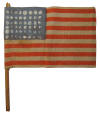 |
Embroidering
Embroidered stars are made by
building up individual stitches of
thread to form the star.
Embroidery is often done by hand,
but by the late 19th century and
through the modern day, machine
embroidery is used to apply stars
that are very regular in size and
shape. Hand embroidered stars
on flags that date to the early 19th
century are known to exist.
 |
Technique: Embroidered.
These crude embroidered
stars on this Civil War era
homemade parade flag are
intricate, yet minute.
The entire flag is just 2.5
inches square, and the
canton just 1.5 inches
square. Yet the flag
features the entire
complement of 34 stars.
The stripes of the flag are
also embroidered. |
 |
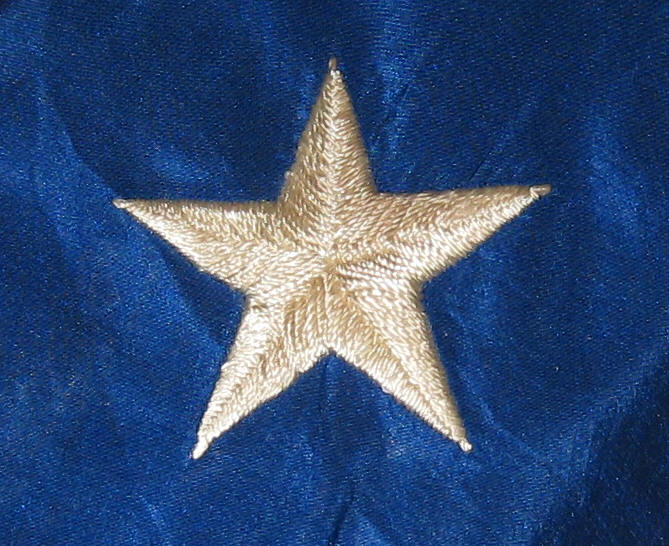 |
Technique:
Embroidered. Here the
entire body of the star is
embroidered. This flag
of 46 stars, circa 1910, is
made of silk and was
produced as a military stand
of colors. |
 |
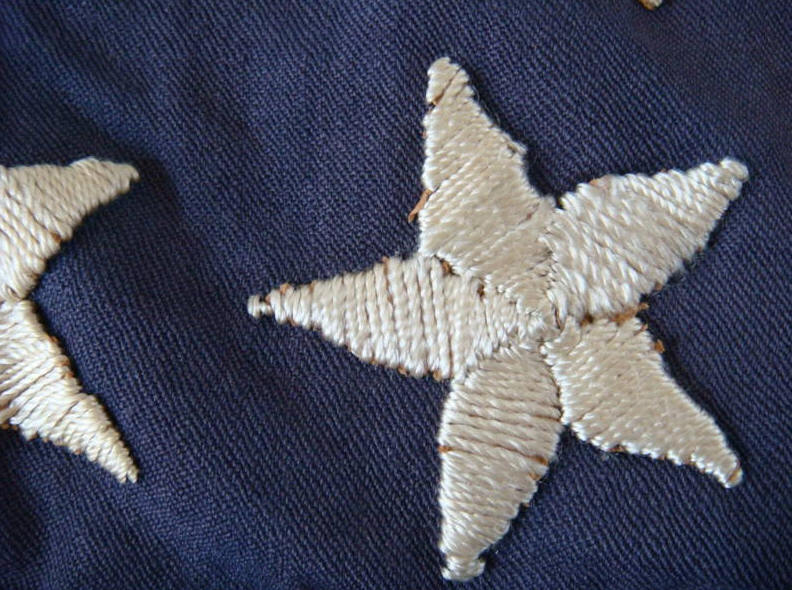 |
|
Technique: Embroidered.
The stars of this hand sewn
homemade 45 star
flag, circa 1900, are hand
embroidered, with the
embroidery covering a base
in order to build up and
define the shape of the
star. |
 |
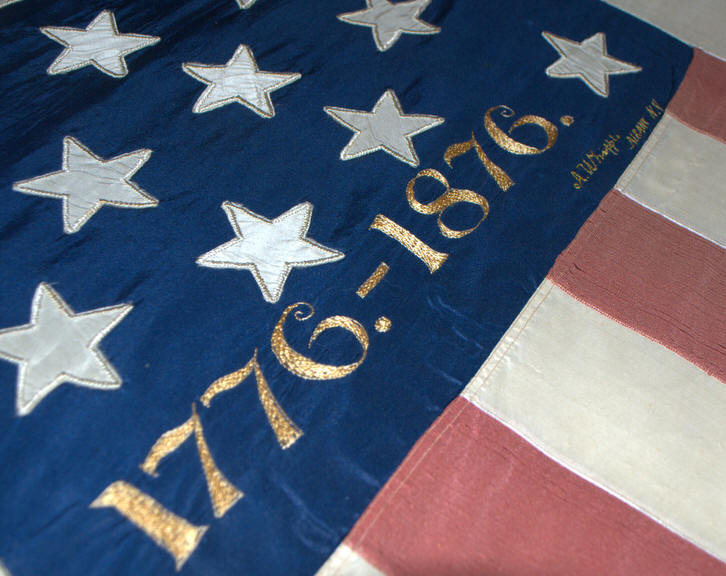 |
|
Technique: Embroidered
stitching. The stars
of this superb homemade flag
from the American Centennial
are made of cut silk, but
rather than being sewn to
the canton with a simple
stitch, the seamstress, Ms.
A. Whipple of Albany, New
York, embroidered the
borders of the stars to
affix them to the canton. |
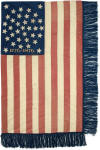 |
Crocheting
Crocheting or knitting is yet
another way to form stars, usually
employed on homemade flags that date
from the early 20th century to the
modern day. Crochet stars are
often folky and very intricate,
especially when made for the cantons
of smaller flags.
Affixing
Stars that are affixed to a flag are
usually made of a material that is
difficult or impossible to stitch
into without causing damage or
undesired effects. The stars
might be made of metallic foil,
plastic or other materials.
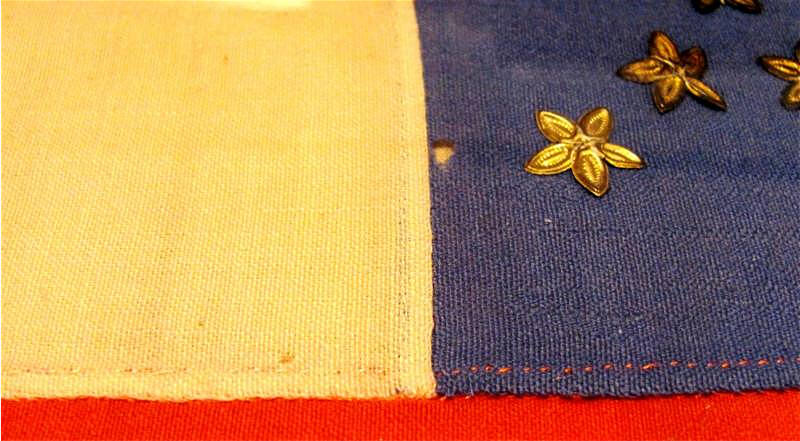 |
Technique: Affixing.
On this Confederate Bible
Flag, fifteen gilt foil
stars are affixed using a
star-shaped cross stitch
across their centers.
The gilt foil is similar to
the material found inside
the cases of Civil War era
photographs. |
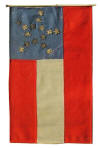 |
Reverse-Appliqué
Reverse-appliquéd construction
involves cutting through the shape
of stars on the canton and sewing
the canton to a single piece of
white fabric, which serves as the
flag. On some reverse-appliqued
flags, the canton is cut and sewn to
both sides of the flag, allowing the
white fabric to show through,
forming stars on both sides.
This technique is very rare and
usually leads to flags with a very
folky appearance.
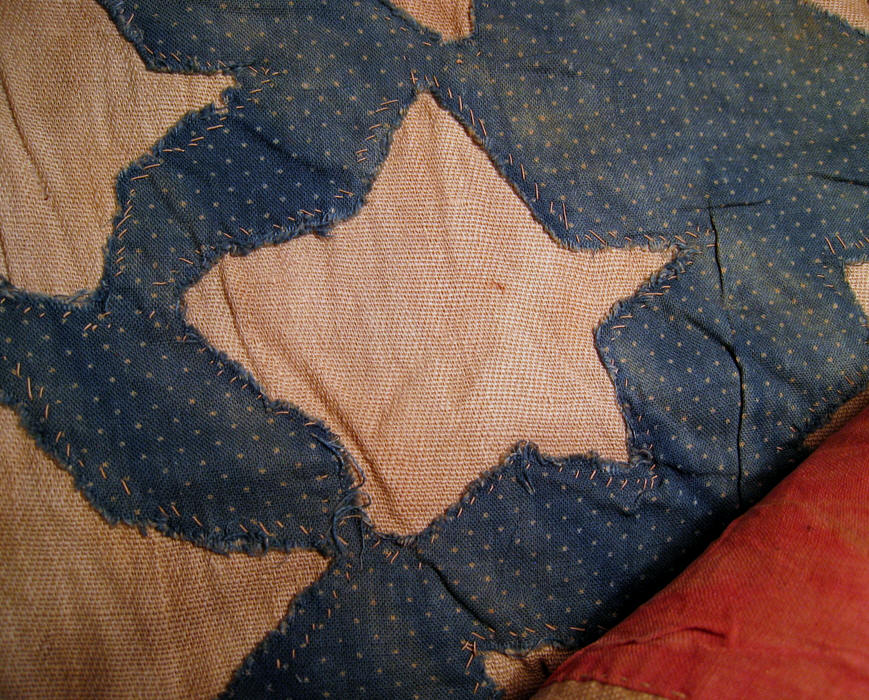 |
|
Technique:
Reverse-Appliqué. This
fantastic flag of the Civil
War period features 35
reverse-appliqué stars on
both sides of the canton, made by
cutting through pieces of
calico dress fabric.
The red stripes are also
appliquéd to the flag on
both sides. The flag
was hung from the Olive
Green General Store in Olive
Green, Ohio on the border of
Ohio and West Virginia.
The three holes across the
flag are bullet holes shot
through by Southern
sympathizers who fired on the
flag as it hung over
the general store,
enduring evidence of tensions within
the region over West
Virginia's secession from
Confederate Virginia.
|
 |
Gluing
Cut stars glued
to the canton are a common way of affixing stars
onto flags made at home or by school children.
|
 |
Next:
Great Star Flags |
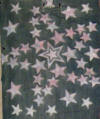 |

